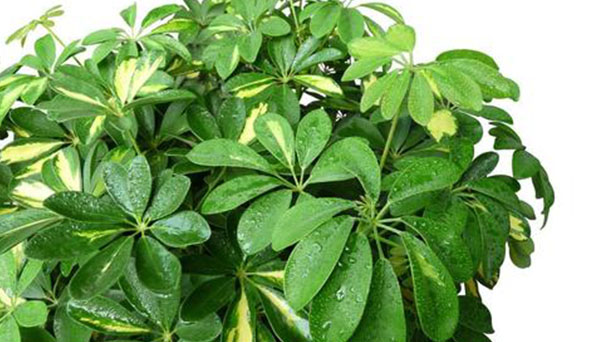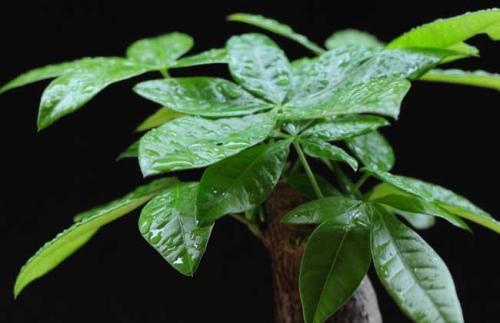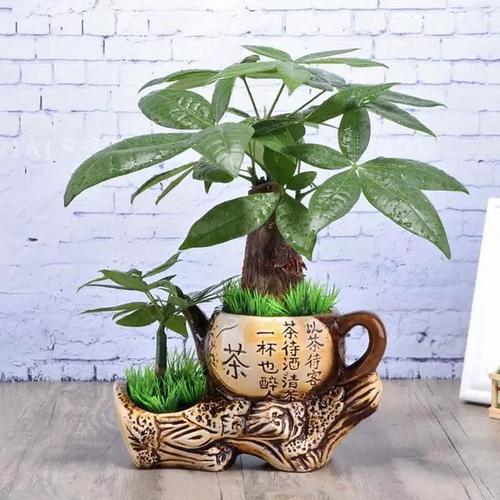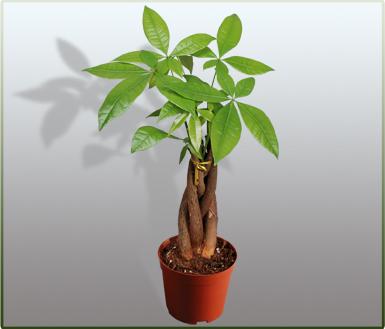Guiana Chestnut Leaves Slime & Drooping Causes & Care Solutions
Written by Maggie
Dec 16 2021

Guiana Chestnut is most commonly sold as a small plant with a braided trunk made up of three, five, or seven stems. The trees are braided by nurseries when they are young and will continue to grow this way as they mature. During the growth period, many problems occur including slime on leaves and leaves dropping. How to care for Guiana Chestnut? Here are some caring tips.

How to care for slime on Guiana Chestnut
The main reason for the mucus on the Guiana Chestnut is insect pests. The main reason is that the growing environment is not suitable. The plants are easy to cause insect pests under the closed, hot and humid environment. If scale insects are found on the leaves, the leaves should be cut off in time. If the number of scale insects is small, the leaves can be treated with soapy water or chili water. If the number of scale insects is large, the plants need to be sprayed with carbapenem solution.
Aphids are also the pest of the Guiana Chestnut. Aphids are one of the common pests of the plant, most of which are caused by the closed and hot environment. If you find any aphids on the leaves of the Guiana Chestnut, you should cut off the leaves and burn them to avoid the second infection. If you want to avoid any aphids, you can use some medicine such as anti-aphid vir, deltamethrin or Deltamethrin to eliminate the aphids on the leaves.
In the use of drugs to the plant, if the leaves of pests or insect eggs more, it must be cut off. Cut off the leaves after the use of chemical insecticides to eliminate insects. Do not use a single agent, as far as possible a variety of agents used alternately, generally 7 to 10 days can spray a plant 1 time. Continuously spraying 3 to 4 times, the pest will gradually reduce.
Put the Guiana Chestnut in a warm and cool environment. Open windows frequently for ventilation and make sure the indoor air circulation. During the curing period, disinfection and bacteriostasis should also be carried out. Generally, the plants should be sprayed with bactericidal agents once every 15 days, such as carbendazim or chlorothalonil, which can prevent the plants from being attacked by diseases and insects.

Guiana Chestnut is one of the best trees for pots
How to care for Guiana Chestnut leaves droop
The droop leaves of the guiana chestnut may be caused by too much light, lack of water for fertilizer, too much water, or the temperature is not right. Shade the plant properly when the light is too strong; Fertilization should be timely when water shortage occurs; Stop watering when you overwater; Adjust the temperature if the temperature is not good.
1. Light for Guiana Chestnut
Guiana Chestnut, is a small tree of the ceiba family. It is often grown as an ornamental potted plant. At this time, it is best to transplant the plant to the indoor semi-shade, ventilated environment in the maintenance, but also do a good job of shading during, in order to prevent the plant from secondary damage.
2. Fertilizer for Guiana Chestnut
When Guiana Chestnut leaves are growing, the sagging stems may be caused by the lack of fertilizer. Fertilize the plant in time. Guiana Chestnut does not require much fertilizer. It is best to dilute the fertilizer with water before fertilizing the plants. This will effectively reduce the fertilizer concentration.
3. Watering for Guiana Chestnut
Guiana Chestnut is a water-loving plant. However, if you water the plants too much, the leaves will dropper and the stems will become weak. Please stop watering and let the excess water out of the soil. During later cultivation of Guiana Chestnut, water the plants according to the changes in the soil. Usually only water the plants when the soil is grey.
4. Temperature for Guiana Chestnut
Guiana Chestnut is native to Central And Central Mexico. It is suitable for growing in high temperature and high humidity. It is not cold resistant. The best temperature should be about 25 ℃ for cultivation Guiana Chestnut, and about 10 ℃ for winter cultivation, and keeping warm.

Other Guiana Chestnut Growing & Care Problems you may be interested in:
- Guiana Chestnut Profile: Plant Info & Complete Care Guide
- How to Take Care of the Guiana Chestnut Plant in Summer & Winter
- Guiana Chestnut Care for Leaf Spots & Shoots Wilting
- How to Propagate Guiana Chestnut (from Seeds & Cuttings)
- How to Care for Guiana Chestnut Leaf Tip Burnt & Trunk Root
- 3 Ways to Propagate Guiana Chestnut
- How to Care for Guiana Chestnut Frizzy & Growing too High
- How to Care for Guiana Chestnut Frostbite & Excessive Growth
- How to Take Care of Guiana Chestnut Leaves Falling & Wilting
- How to Care for Guiana Chestnut Root Rot or Leaf Yellowing
- How to Care for Guiana Chestnut Leaves Saggy or No Buds
Latest Updated
- Benefits of Bugleweed - 7 Science-backed Health Benefits
- Bugleweed Dangers & Side Effects - Is It Poisonous?
- How to Plant Evergreen Trees - What You Should Know
- When to Plant Evergreens - Grow Guide for Evergreen Trees
- 12 Wonderful Evergreen Shrubs for Your Garden
- 12 Popular Evergreen Plants with Pictures for Beginners
- When And How To Prune A Lilac Bush Like a Pro
- How to Grow & Care for Lilac Vine (Hardenbergia Violacea)
- Japanese Lilac Tree (Syringa Reticulata) Care & Propagation Guide
- Shumard Oak Pros and Cons - What to Know
Popular Articles
- Winter maintenance of Antirrhinum Majus
- How to Grow Terminalia Mantaly Tree
- How to Grow and Care for Crossostephium Chinense
- How to grow Antirrhinum Majus in spring
- Peristeria Elata (Dove Orchid) Profile: Info & Care Guide
- Underwatered Snake Plant (Sansevieria Trifasciata) - Signs And How To Fix
- How to Care for Brazilian Jasmine Plant (Mandevilla Sanderi)
- How to Grow & Care for Graptopetalum Purple Delight in Summer
- Rosa Chinensis (China Rose): Plant Growing & Care Tips
- How to Care for Baby Sun Rose (Aptenia Cordifolia)